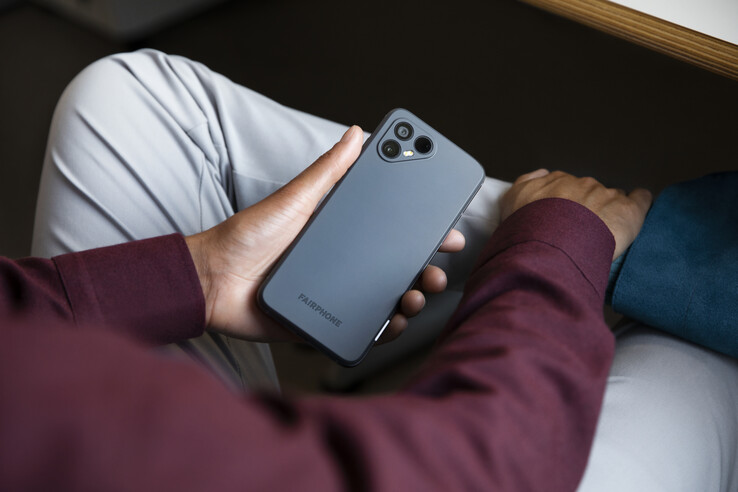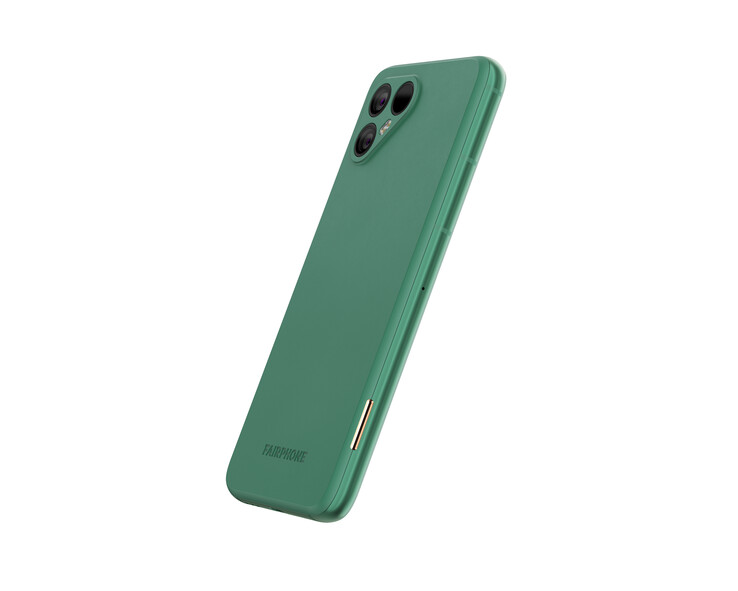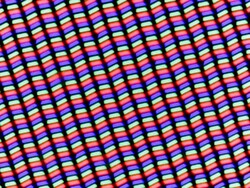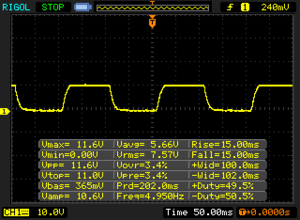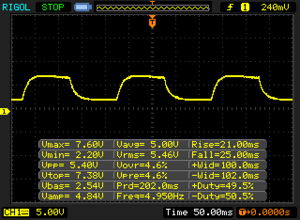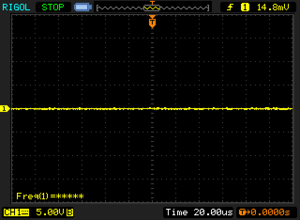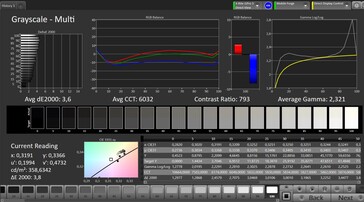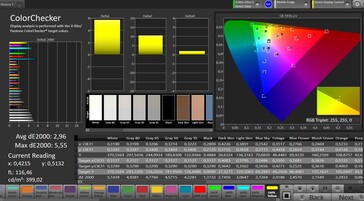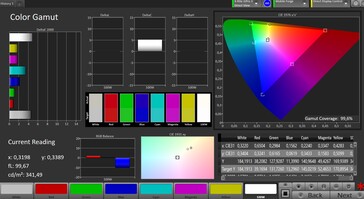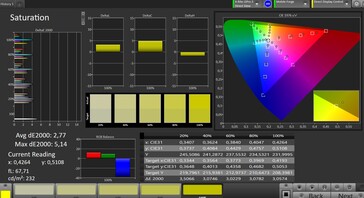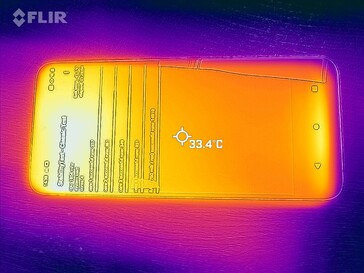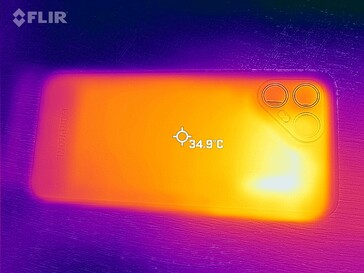Fairphone 4 smartphone review - 5G phone with environmental focus
Possible competitors in comparison
Rating | Date | Model | Weight | Drive | Size | Resolution | Best Price |
|---|---|---|---|---|---|---|---|
| 80.5 % | 02/2022 | Fairphone 4 SD 750G 5G, Adreno 619 | 225 g | 128 GB UFS 2.1 Flash | 6.30" | 2340x1080 | |
| 76.5 % | 02/2020 | Fairphone 3 SD 632, Adreno 506 | 189 g | 5.65" | 2160x1080 | ||
| 79.1 % | mobilcom-debitel rephone Helio G85, Mali-G52 MP2 | 208 g | 128 GB eMMC Flash | 6.30" | 2340x1080 | ||
| 80.6 % | 05/2021 | Nokia X20 SD 480, Adreno 619 | 220 g | 128 GB UFS 2.1 Flash | 6.67" | 2400x1080 |
Case and features - Modular, but a bit clunky
A modern smartphone consists of hundreds of components, and most of them require raw materials that are not easy to come by. Nevertheless, most devices end up in the trash after a few years or even months because they are broken or a new smartphone is needed.
Fairphone wants to change that and has always made its phones as easy to repair as possible, tries to purchase raw materials fairly where possible, and wants to improve the conditions of workers throughout the production chain. The manufacturer's latest device is called Fairphone 4 and is supposed to combine modern features with sustainability.
To check these promises, the buyer can access comprehensive reports about every single phone on the website or trust the numerous sustainability seals that the latest Fairphone 4 or the manufacturer has, among others the Blue Angel or the 9.3/10 for repairability at iFixit.
Spare parts can be replaced quickly and easily thanks to normal Phillips screws and the simplest possible design, and the battery can also be removed and replaced easily. This brings the disadvantage that the build of the Fairphone 4 cannot be as slim as other phones, and the weight is also quite high at 225 grams (~7.9 oz).
The chassis is made of aluminum, whereas the removable and rubberized back is made of recycled plastic. Here you can choose whether you want gray, pure green or green with visible colored pieces of recycled plastic. Additional back covers can be purchased from the manufacturer for just under 20 Euros (~$23). The casing is protected according to IP54, so dust cannot cause any damage, nor can splashing water.
128 GB mass storage / 6 GB RAM or 256 GB storage / 8 GB RAM are available as options. The smaller model costs 580 Euros (~$654), the better equipped 650 Euros (~$733). Charging cable and charger have to be purchased separately. The Fairphone 4 is of course a bit more expensive than the absolute bargains of the upper mid-range here, but you at least get a long warranty with 5 years.
The SD card reader is separate and achieves normal transfer rates with our reference card Angelbird V60. Only a physical SIM card can be inserted, but an eSIM can also be used.
| SD Card Reader - average JPG Copy Test (av. of 3 runs) | |
| Average of class Smartphone (10.9 - 77, n=97, last 2 years) | |
| Fairphone 4 (Angelbird V60) | |
| mobilcom-debitel rephone (Angelbird V60) | |
Cross Platform Disk Test (CPDT)
Communication, software and operation - On request also without Google
NFC for mobile payment services and other applications is on board. It is nice that Fairphone installs a fast USB-C 3.1 port that speeds up data transfer and can also serve as a DisplayPort for the monitor connection.
The Fairphone 4 also comes with WiFi 5 and is thus fast on the Internet. Compared with the predecessor, clear progress can be seen in the speeds and the stability of the connection. The mobile Internet is now also up to date: 5G is supported with some frequencies, and there is also a sufficient number of 4G bands so that the smartphone can often be used abroad.
Android 11 is preinstalled, and the manufacturer promises at least 5 years of updates from the end of 2022. The latest security patches were from December 2021 at the time of testing and are thus still quite up-to-date. Widevine-L1 certification is available, so streaming services can also be used in HD.
If you would rather have a Fairphone without Google services, you can download the specially adapted /e/OS download or buy a Fairphone with preinstalled /e/OS from the e.Foundation.
The touchscreen can be operated smoothly, and a fingerprint sensor is integrated in the standby button on the right. It also works reliably and unlocks the device quickly. You can choose whether you want to press the button first to activate the fingerprint sensor or whether it should always be activated. The always-on mode is obviously more convenient, but the sensor reacts very sensitively if you accidentally touch the standby button with another finger.
| Networking | |
| iperf3 transmit AX12 | |
| mobilcom-debitel rephone | |
| Fairphone 4 | |
| Nokia X20 | |
| Fairphone 3 | |
| iperf3 receive AX12 | |
| Fairphone 4 | |
| mobilcom-debitel rephone | |
| Nokia X20 | |
| Fairphone 3 | |
Cameras - High-quality 48-megapixel camera in the Fairphone
The main camera of the Fairphone 4 has a resolution of 48 megapixels, but only takes 12-megapixel photos by default. In return, 4 pixels are combined into one, which enables a higher light yield. However, photos can also be recorded with the full resolution if required.
The photos of the main camera also look quite sharp in detail and show a quite clean image. However, low-light situations are not the camera's strength.
The Fairphone 4 also has a wide-angle lens with a high resolution. This can also produce decent pictures, but you should not enlarge them too much; they are quite inaccurate in detail. A hybrid zoom between the cameras is possible. If you like, you can also take macro pictures with this camera.
Videos can be recorded in 4K at 30 fps or in 1080p at 60 fps. The recordings are decent, but the smartphone acts a bit abruptly during brightness changes. The autofocus does its job quickly and quite accurately. The wide-angle camera cannot be used for videos in the preloaded app.
A 25-megapixel camera is found on the front, but its pictures look quite unclean on closer inspection.
Image Comparison
Choose a scene and navigate within the first image. One click changes the position on touchscreens. One click on the zoomed-in image opens the original in a new window. The first image shows the scaled photograph of the test device.
Main camera PlantMain camera EnvironmentMain camera Low LightWide-angle camera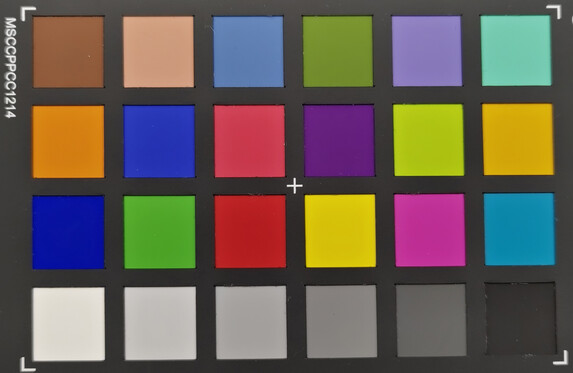

Display - No PWM with the environmental phone
The Full HD IPS screen has the brightness typical for the class, but cannot keep up with OLED screens in this respect. However, it should be sufficient for occasional outdoor use.
The black value is quite high in our measurements, which causes the contrast ratio to drop below 1000:1 and colors to no longer look as bright.
We did not notice PWM flickering and colors are rendered reasonably accurately in the adjustable color mode "Natural", but OLED screens are ahead here as well. A slightly brownish color cast is visible in the grayscale.
| |||||||||||||||||||||||||
Brightness Distribution: 88 %
Center on Battery: 513 cd/m²
Contrast: 950:1 (Black: 0.54 cd/m²)
ΔE Color 2.96 | 0.5-29.43 Ø5
ΔE Greyscale 3.6 | 0.57-98 Ø5.3
99.6% sRGB (Calman 2D)
Gamma: 2.321
| Fairphone 4 IPS, 2340x1080, 6.30 | Fairphone 3 IPS, 2160x1080, 5.65 | mobilcom-debitel rephone IPS, 2340x1080, 6.30 | Nokia X20 IPS, 2400x1080, 6.67 | |
|---|---|---|---|---|
| Response Times | -7% | 20% | 24% | |
| Response Time Grey 50% / Grey 80% * | 46 ? | 57.6 ? -25% | 31 ? 33% | 43 ? 7% |
| Response Time Black / White * | 30 ? | 26.8 ? 11% | 28 ? 7% | 18 ? 40% |
| PWM Frequency | 22320 ? | |||
| Screen | -55% | -46% | -26% | |
| Brightness middle | 513 | 511 0% | 503 -2% | 646 26% |
| Brightness | 492 | 489 -1% | 471 -4% | 617 25% |
| Brightness Distribution | 88 | 92 5% | 88 0% | 89 1% |
| Black Level * | 0.54 | 0.48 11% | 0.3 44% | 0.7 -30% |
| Contrast | 950 | 1065 12% | 1677 77% | 923 -3% |
| Colorchecker dE 2000 * | 2.96 | 7.4 -150% | 8.54 -189% | 5.71 -93% |
| Colorchecker dE 2000 max. * | 5.55 | 14.2 -156% | 13.32 -140% | 8.9 -60% |
| Greyscale dE 2000 * | 3.6 | 9.5 -164% | 9 -150% | 6.2 -72% |
| Gamma | 2.321 95% | 2.21 100% | 1.869 118% | 2.122 104% |
| CCT | 6032 108% | 9381 69% | 8942 73% | 8256 79% |
| Total Average (Program / Settings) | -31% /
-46% | -13% /
-32% | -1% /
-16% |
* ... smaller is better
Display Response Times
| ↔ Response Time Black to White | ||
|---|---|---|
| 30 ms ... rise ↗ and fall ↘ combined | ↗ 15 ms rise | |
| ↘ 15 ms fall | ||
| The screen shows slow response rates in our tests and will be unsatisfactory for gamers. In comparison, all tested devices range from 0.1 (minimum) to 240 (maximum) ms. » 77 % of all devices are better. This means that the measured response time is worse than the average of all tested devices (21.5 ms). | ||
| ↔ Response Time 50% Grey to 80% Grey | ||
| 46 ms ... rise ↗ and fall ↘ combined | ↗ 21 ms rise | |
| ↘ 25 ms fall | ||
| The screen shows slow response rates in our tests and will be unsatisfactory for gamers. In comparison, all tested devices range from 0.2 (minimum) to 636 (maximum) ms. » 76 % of all devices are better. This means that the measured response time is worse than the average of all tested devices (33.7 ms). | ||
Screen Flickering / PWM (Pulse-Width Modulation)
| Screen flickering / PWM not detected | |||
In comparison: 53 % of all tested devices do not use PWM to dim the display. If PWM was detected, an average of 17924 (minimum: 5 - maximum: 3846000) Hz was measured. | |||
Performance, emissions and battery life - Fast, but also warm
The Qualcomm Snapdragon 750G 5G is used as the SoC. It offers good mid-range performance. There are certainly devices from Xiaomi or OnePlus that offer more power for much less money, but then without a focus on sustainability.
The Fairphone 4's power is definitely sufficient for everyday use, even when more complex apps are used. Compared to the Fairphone 3 or other sustainable phones, the Fairphone 4 is much faster. Thanks to UFS 2.1, the device can convince in terms of storage speed.
The test device heats up considerably under longer load: We measured a maximum of 47.7 °C (~118 °F) on the case. That is already very noticeable, although not yet unpleasant. However, we also measured at room temperature; the device's exterior could actually get too warm in very hot environments.
Stereo speakers are included in the sustainable smartphone, but they sound a bit thin. At least the trebles are not unpleasantly overemphasized. Users can connect external audio devices via USB-C or Bluetooth, and all current aptX codecs are supported.
The battery with 3,905 mAh lasted 13:24 hours in our WLAN test. That is not a bad runtime, especially since you can double the runtime by replacing the removable battery. Compared to the Fairphone 3, the successor also runs significantly longer. However, other sustainable phones offer slightly bigger batteries and thus even more stamina.
The smartphone can be charged with a maximum of 20 watts, but you have to provide the charger and charging cable yourself; they are not included in the scope of delivery. Charging is completed in a maximum of 100 minutes.
| Geekbench 5.5 | |
| Single-Core | |
| Average of class Smartphone (119 - 2138, n=216, last 2 years) | |
| Average Qualcomm Snapdragon 750G 5G (632 - 658, n=9) | |
| Fairphone 4 | |
| Nokia X20 | |
| mobilcom-debitel rephone | |
| Fairphone 3 | |
| Multi-Core | |
| Average of class Smartphone (473 - 6681, n=216, last 2 years) | |
| Average Qualcomm Snapdragon 750G 5G (1792 - 2009, n=9) | |
| Fairphone 4 | |
| Nokia X20 | |
| mobilcom-debitel rephone | |
| Fairphone 3 | |
| PCMark for Android - Work 3.0 | |
| Average of class Smartphone (4761 - 21385, n=212, last 2 years) | |
| mobilcom-debitel rephone | |
| Average Qualcomm Snapdragon 750G 5G (7498 - 9800, n=5) | |
| Fairphone 4 | |
| GFXBench | |
| on screen Aztec Ruins Normal Tier Onscreen | |
| Average of class Smartphone (3.6 - 123, n=224, last 2 years) | |
| Fairphone 4 | |
| Average Qualcomm Snapdragon 750G 5G (7.1 - 33, n=9) | |
| Nokia X20 | |
| mobilcom-debitel rephone | |
| Fairphone 3 | |
| 1920x1080 Aztec Ruins Normal Tier Offscreen | |
| Average of class Smartphone (2.3 - 229, n=224, last 2 years) | |
| Fairphone 4 | |
| Average Qualcomm Snapdragon 750G 5G (17 - 20, n=9) | |
| Nokia X20 | |
| mobilcom-debitel rephone | |
| Fairphone 3 | |
| on screen Aztec Ruins High Tier Onscreen | |
| Average of class Smartphone (2.8 - 105, n=224, last 2 years) | |
| Average Qualcomm Snapdragon 750G 5G (6.7 - 21, n=9) | |
| Fairphone 4 | |
| Nokia X20 | |
| mobilcom-debitel rephone | |
| Fairphone 3 | |
| 2560x1440 Aztec Ruins High Tier Offscreen | |
| Average of class Smartphone (0.85 - 94, n=224, last 2 years) | |
| Fairphone 4 | |
| Average Qualcomm Snapdragon 750G 5G (3.3 - 7.6, n=9) | |
| Nokia X20 | |
| mobilcom-debitel rephone | |
| Fairphone 3 | |
| Fairphone 4 | Fairphone 3 | mobilcom-debitel rephone | Nokia X20 | Average 128 GB UFS 2.1 Flash | Average of class Smartphone | |
|---|---|---|---|---|---|---|
| AndroBench 3-5 | -68% | -49% | 15% | -1% | 150% | |
| Sequential Read 256KB | 917 | 132.9 -86% | 308 -66% | 489.3 -47% | 760 ? -17% | 1505 ? 64% |
| Sequential Write 256KB | 214.8 | 130.1 -39% | 190 -12% | 462.7 115% | 297 ? 38% | 1112 ? 418% |
| Random Read 4KB | 158.5 | 71.3 -55% | 105.8 -33% | 165.4 4% | 152.9 ? -4% | 247 ? 56% |
| Random Write 4KB | 168.7 | 16.96 -90% | 22.9 -86% | 144.6 -14% | 131.6 ? -22% | 271 ? 61% |
Temperature
(-) The maximum temperature on the upper side is 45.2 °C / 113 F, compared to the average of 35 °C / 95 F, ranging from 21.9 to 56 °C for the class Smartphone.
(-) The bottom heats up to a maximum of 47.7 °C / 118 F, compared to the average of 33.8 °C / 93 F
(+) In idle usage, the average temperature for the upper side is 30 °C / 86 F, compared to the device average of 32.7 °C / 91 F.
Speaker
Fairphone 4 audio analysis
(+) | speakers can play relatively loud (83.9 dB)
Bass 100 - 315 Hz
(-) | nearly no bass - on average 35% lower than median
(±) | linearity of bass is average (11.6% delta to prev. frequency)
Mids 400 - 2000 Hz
(±) | higher mids - on average 6% higher than median
(±) | linearity of mids is average (8.1% delta to prev. frequency)
Highs 2 - 16 kHz
(+) | balanced highs - only 3.4% away from median
(+) | highs are linear (5.2% delta to prev. frequency)
Overall 100 - 16.000 Hz
(±) | linearity of overall sound is average (23.7% difference to median)
Compared to same class
» 47% of all tested devices in this class were better, 9% similar, 44% worse
» The best had a delta of 12%, average was 38%, worst was 134%
Compared to all devices tested
» 66% of all tested devices were better, 7% similar, 27% worse
» The best had a delta of 4%, average was 25%, worst was 134%
Nokia X20 audio analysis
(+) | speakers can play relatively loud (83.4 dB)
Bass 100 - 315 Hz
(-) | nearly no bass - on average 25.3% lower than median
(±) | linearity of bass is average (11.6% delta to prev. frequency)
Mids 400 - 2000 Hz
(±) | higher mids - on average 8% higher than median
(±) | linearity of mids is average (7.5% delta to prev. frequency)
Highs 2 - 16 kHz
(±) | higher highs - on average 6.8% higher than median
(±) | linearity of highs is average (8.4% delta to prev. frequency)
Overall 100 - 16.000 Hz
(±) | linearity of overall sound is average (27% difference to median)
Compared to same class
» 65% of all tested devices in this class were better, 6% similar, 29% worse
» The best had a delta of 12%, average was 38%, worst was 134%
Compared to all devices tested
» 80% of all tested devices were better, 4% similar, 16% worse
» The best had a delta of 4%, average was 25%, worst was 134%
Battery life
| Fairphone 4 3905 mAh | Fairphone 3 3000 mAh | mobilcom-debitel rephone 4500 mAh | Nokia X20 4470 mAh | Average of class Smartphone | |
|---|---|---|---|---|---|
| Battery Runtime | |||||
| WiFi Websurfing | 804 | 662 -18% | 898 12% | 879 9% | 913 ? 14% |
Pros
Cons
Verdict - Sustainably convincing
The Fairphone 4 modernizes the concept of the modular, fair, sustainable smartphone in many ways. Of course, the casing is not as slim and chic as current high-end smartphones, and there are certainly more powerful phones for around 600 Euros (~$676).
However, we had the impression in the test that Fairphone managed a good compromise of high-quality appearance, performance suitable for everyday use, decent camera and the sustainable concept of the phone. This includes the screwed and easily replaceable components, fair production conditions, comprehensible environmental balances, and also the freedom of choice regarding a Google-free Android.
It is also nice that the manufacturer confidently avoids small stumbling blocks in DRM certification, update times or the USB-C port and supplies good equipment in all areas. The close contact to the community was and is certainly helpful here.
The Fairphone 4 is a modern, well-equipped smartphone that convinces with its modular and sustainable concept.
If you want to have a somewhat calmer conscience when buying a smartphone, if the exchangeable components including battery are important to you, and if you still do not want to do without modern features like 5G, fast Wi-Fi, and high performance, you will get a good overall package in the Fairphone 4.
A cheaper alternative is the rephone from mobilcom-debitel, but it is hardly available outside Europe. Nokia also tries to become more sustainable with long update cycles and fewer accessories, and offers a new device with the Nokia X20 a cheaper, but also less repairable smartphone.
Price and availability
The Fairphone 4 is available directly from the manufacturer (DE), and the Speckled Green color is exclusively available there. It is also available on Amazon (US) for $834.70.
Fairphone 4
-
01/29/2022 v7
Florian Schmitt


 Deutsch
Deutsch English
English Español
Español Français
Français Italiano
Italiano Nederlands
Nederlands Polski
Polski Português
Português Русский
Русский Türkçe
Türkçe Svenska
Svenska Chinese
Chinese Magyar
Magyar